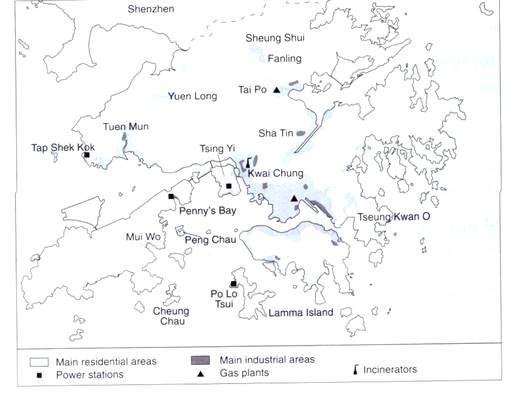C4.1 What is pollution?
There are four common types of pollution:
4. solid-waste pollution
1. Urban development
2. Industrial development
Rapid industrial development causes pollution, e.g.:
--air pollution is caused by the increased use of fossil fuels
--water pollution is caused by industrial sewage and waste heat
--noise pollution is caused by factories and power stations
--solid waste pollution is caused by industrial waste
3. Man’s technological capabilities
Improvement in man’s technological capabilities causes:
-–an increase in energy generation and consumption
-–an increase in manufacturing activities
--an increase in the exploitation of natural resources
--an increase in the use of persistent pollutants and products,e.g. DDT
C4.4 Pollution in Hong Kong
- Definition
Air pollution occurs when the air contains chemicals in such a high concentration that both the living and non-living environments are harmed

Pollution Sources in Hong Kong
Major sources of air pollution |
Effect of air pollution |
Power station
|
1. Increasing composition of carbon dioxide in the air affects microclimate 2. High concentrations of air 3. sulphur dioxide (SO2) dissolved in rain cause acid rain which damages organisms , soil and buildings |
- Definition:
Water pollution occurs when some substance or condition causes deterioration of water quality to such a degree that the water cannot meet a specific standard or the water cannot be used for a specific purpose.
- Water pollution can be classified into two types:
- coastal pollution
- stream pollution
Major sources of water pollution |
Effect of water pollutants |
Domestic source |
1. Sewage increases the temperature and turbidity of water which encourages the growth of algae |
- Definition:
Noise is usually defined as ‘unwanted sound ‘.
Major sources of noise pollution |
Effect of noise pollution |
Neighborhood noise e.g. mahjong,karaoke |
1. mental stress and heart disease |
- Definition:
Solid-waste refers to any useless or unwanted solid material that has been disposed.
Major sources of solid waste pollution |
Effect of solid waste pollution |
Domestic source |
1.a bad smell is created 2.toxic chemicals and metals are harmful to man’s health 3.spoils beautiful scenery
4.spread disease |
Air Pollution Control Ordinance
Water Pollution Control Ordinance
Noise Control Ordinance
Waste Disposal Ordinance
a. Smoke , dust and gases are filtered before discharge by installation of equipment
b. Sewage, animal waste, glass, etc. are treated and recycled
D. Education
a. public awareness on environmental conservation is raised by education , e.g. , the school curriculums and world Environment Day
E. Specific measures for different types of pollution
a. raising taxes to discourage private car ownership
b. monitoring air quality by setting up an air pollution index
c. encourage motorists to replace their old cars
d. encourage the use of LPG-powered vehicles
2. Solutions to Water pollution
3. Solutions to noise pollution
schools seriously affected by noise
4. Solutions to Solid waste pollution
a. sanitary landfill
b. encourage the use of biodegradable lunch boxes
c. composition
The following table shows the average daily solid waste in 1996 in Hong Kong.
Types of solid waste |
Tones |
Domestic waste |
6,400 |
Commercial waste |
1,000 |
Industrial waste |
8,00 |
Special waste |
500 |
Recovered waste |
3,100 |
Construction waste |
7,500 |
Total |
19,300 |
(a) Draw a pie chart to show the proportion of different types of solid waste. (3marks)
environment? (4 marks)
_____________________________________________________________________________________________________________________________________________________________________________________________________________________________________________________________________________________________
( c)What are the roles of
(i) the government and (4 marks)
(ii) citizens (4 marks)
to alleviate solid waste pollution?
______________________________________________________________________________________________________________________________________________________________________________________________________________________________________________________________________________________________________________________________________________________
Source: https://resources.hkedcity.net/downloadResource.php?rid=1201660069&pid=564910992
Web site to visit: https://resources.hkedcity.net
Author of the text: indicated on the source document of the above text
If you are the author of the text above and you not agree to share your knowledge for teaching, research, scholarship (for fair use as indicated in the United States copyrigh low) please send us an e-mail and we will remove your text quickly. Fair use is a limitation and exception to the exclusive right granted by copyright law to the author of a creative work. In United States copyright law, fair use is a doctrine that permits limited use of copyrighted material without acquiring permission from the rights holders. Examples of fair use include commentary, search engines, criticism, news reporting, research, teaching, library archiving and scholarship. It provides for the legal, unlicensed citation or incorporation of copyrighted material in another author's work under a four-factor balancing test. (source: http://en.wikipedia.org/wiki/Fair_use)
The information of medicine and health contained in the site are of a general nature and purpose which is purely informative and for this reason may not replace in any case, the council of a doctor or a qualified entity legally to the profession.
The texts are the property of their respective authors and we thank them for giving us the opportunity to share for free to students, teachers and users of the Web their texts will used only for illustrative educational and scientific purposes only.
All the information in our site are given for nonprofit educational purposes